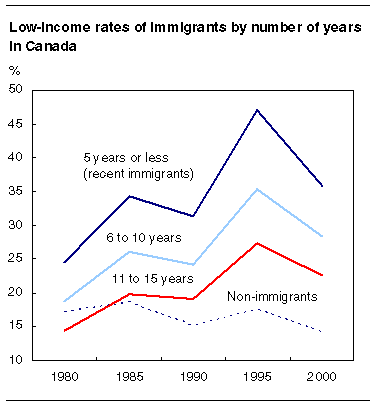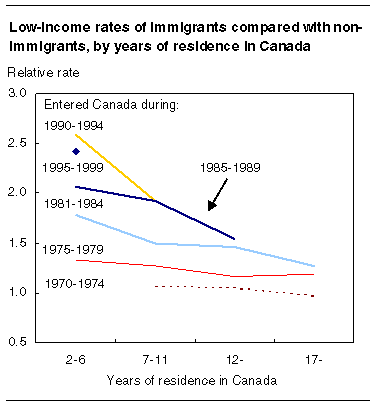
















 |
|
 |                |
Information identified as archived is provided for reference, research or recordkeeping purposes. It is not subject to the Government of Canada Web Standards and has not been altered or updated since it was archived. Please "contact us" to request a format other than those available.

|

Thursday, June 19, 2003 Low-income rates among immigrants1980 to 2000The low-income rate among the most recent immigrants to Canada almost doubled from 1980 to 1995, before easing back during the last half of the 1990s, according to a major new study that analyses data from the census. As a result, the gap in the low-income rate between recent immigrants and Canadian-born individuals widened significantly during the past two decades. In 1980, low-income rates among immigrants who had arrived between 1975 and 1980 were 1.4 times those of people born in Canada. In 1990, low-income rates among immigrants who arrived between 1985 and 1990 were 2.1 times those of the Canadian-born; by 2000, low-income rates among recent immigrants were 2.5 times those of the Canadian-born. (For the purposes of this release, "recent" immigrants are those who arrived in Canada during the five years before the census in question.) Changes in the characteristics of immigrants, such as their country of origin, education, language, age and family structure, were substantial during this period, and may have contributed to rising low-income rates among immigrants. However, these factors accounted for less than one-half of the increase in low income among immigrants from 1980 to 2000, and likely considerably less than one-half. It is not possible to be more precise because of issues in interpreting the analytical results. The increase in low-income rates was widespread among recent immigrants in all education levels, all age groups and language types, and for those in all family types. There was some variation by region of origin. Rates rose primarily among immigrants from the newer regions of origin from which a large and rising share of immigrants originates, notably Asia (except Southeast Asia), Africa and Southern Europe. Rates fell marginally among recent immigrants from the United States, the Caribbean, Western Europe and Southeast Asia, but collectively these regions accounted for only 17% of recent immigrants in 2001. The overall rise, however, did not stem solely from an increase in a certain type of immigrant. The low-income rates of recent immigrants fall with time spent in Canada. There are signs that the higher the low-income rate at entry, for example among immigrants entering during the 1990s, the faster the decline (improvement) as they acquire Canadian experience. Low-income rates rise among successive groups of immigrantsDuring the past two decades, low-income rates have increased among successive groups of newly-arrived immigrants. In 1980, 24.6% of immigrants who had arrived during the previous five-year period were below Statistics Canada's low-income cutoffs. By 1990, the low-income rate among recent immigrants had increased to 31.3%. After peaking at 47.0% in 1995, the rate fell back significantly to 35.8% in 2000. Long-term comparisons are best made using years that are in comparable positions in the business cycle, in this case 1980, 1990 and 2000 - all years that are roughly at the peak of economic activity. This comparison indicates a long-term upward trend in the low-income rate, and one that was not associated with poorer general economic conditions in 2000. The national unemployment rate was in fact only 6.8% in 2000, lower than it was in 1990 (8.1%) or 1980 (7.5%). Furthermore, the trend was not associated with a general rise in low-income rates in Canada, since among the Canadian-born population, the low-income rate declined from 17.2% in 1980 to 14.3% in 2000. 
Although the increase in low-income rates was greatest among recently arrived immigrants, it was also observed among those in Canada for a number of years. For example, among immigrants who have been in Canada between 6 and 10 years, the low-income rate rose from 18.7% in 1980 to 28.4% in 2000. Among immigrants who have been in Canada between 11 and 15 years, the rate rose from 14.4% to 22.7% over the same period. Only among immigrants in Canada for more than 20 years did rates not rise. This population more closely resembled the Canadian-born in terms of low-income trends. Low-income rates rose among immigrants, fell among the Canadian-bornAmong the Canadian-born population as a whole, low-income rates declined during the past two decades, while they increased among most immigrant groups. Among all immigrants as a group, the low-income rate rose from 17.0% in 1980 to 20.2% in 2000. Among recent immigrants, it rose from 24.6% to 35.8%. However, the low-income rate fell among most Canadian-born groups. For the Canadian-born population as a whole, the low-income rate declined from 17.2% in 1980 to 14.3% in 2000. Even among some of the more vulnerable Canadian-born populations with traditionally high low-income rates, there were improvements during the two decades. For example, among seniors, the rate fell 12.5 percentage points; among single-parent families, it fell 16.0 percentage points during the past 20 years. As a result, most of the increase in the low-income rate during the 1990s - in particular in Toronto, Vancouver and Montréal, which have significant immigrant populations - was concentrated among immigrants. However, this pertained to change over time. In terms of levels, most of the low-income population is not immigrant. Immigrants constituted 29% of the low-income population in Canada in 2000, compared with 22% of the total population. In 1980, they made up 20% of both the low-income population and total population. Low-income rates fall as immigrants acquire Canadian experienceAs newly arrived immigrants acquire experience in Canada, their low-income rates fall, both in actual levels and relative to the Canadian-born population. In general, the higher the low-income rate at time of entry, the faster it declines as Canadian experience is acquired. For example, the low-income rate of immigrants who arrived in Canada between 1981 and 1984, measured shortly after they arrived, was 1.8 times that of Canadian-born people. However, after 17 to 21 years in Canada, their rate fell to about 1.3 times the rate among Canadian-born people. Among the group that arrived in Canada between 1990 and 1994, low-income rates were well above those of the group that entered in the late 1980s. However, after spending seven to 11 years in Canada, both groups had the same low-income rate. This suggests that there is some "catch-up" taking place, as immigrants in more recent years, who have higher low-income rates at entry, see their rates fall faster with time spent in Canada. 
Why the increase in low-income among immigrants?In spite of the needs of the knowledge-based economy, having a university degree - no matter what the discipline - did not protect recent immigrants from a rising probability of having a low income. In fact, the gap in low-income rates between the Canadian-born and recent immigrants was highest among those who had a university degree, particularly those with applied science degrees. So why the increase in low-income among immigrants? The major component of family income is earnings, so the well-documented decline in an immigrant's earnings at the time of arrival is obviously associated with the rise in low income to a considerable extent. One factor affecting earnings may have been poor economic conditions in Canada at time of entry, particularly for entrants of the early 1990s. Immigrants arriving in Canada in the early to mid-1990s in particular entered a labour market with virtually no full-time employment growth. In addition, there were generally deteriorating outcomes for labour market entrants in general, including young Canadians, who have experienced declining earnings over the past 20 years. Immigrants are part of the new labour market entrants group, and would be affected by the same trends. There were also declining returns for foreign work experience, as during the 1990s Canadian firms may have recognized experience obtained in other countries less than they used to. Higher education credentials from foreign universities may also have received less recognition. And finally, there was a rapid increase in the domestic supply of highly educated young Canadians. While the demand for highly educated people increased rapidly in Canada, so too did the supply. The research paper The rise in low-Income rates among immigrants in Canada (11F0019MIE2003198, free) is now available on Statistics Canada's website (). From the Studies page, under Browse periodicals and series, choose Free and for sale, then Analytical Studies Branch. For more information, or to enquire about the concepts, methods or data quality of this release, contact Garnett Picot (613-951-8214), Business and Labour Market Analysis Division. |
|
|
|